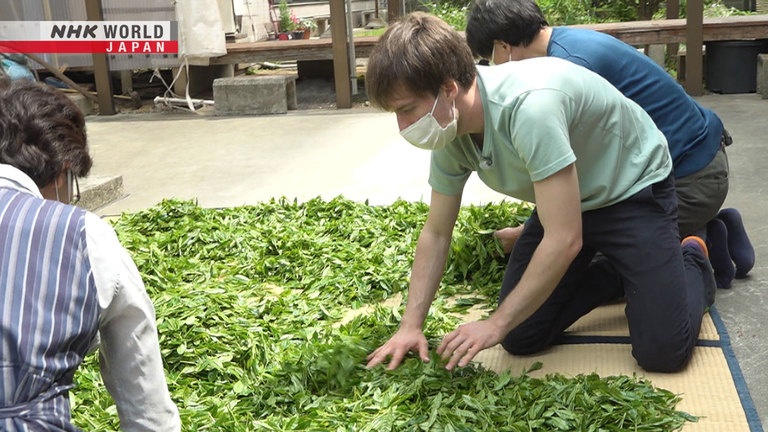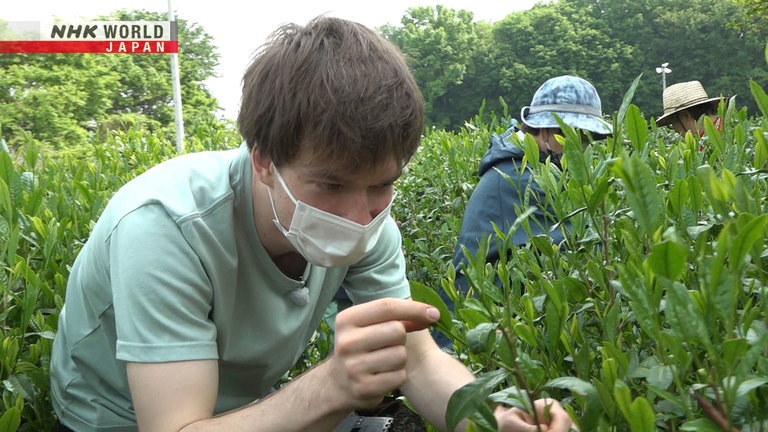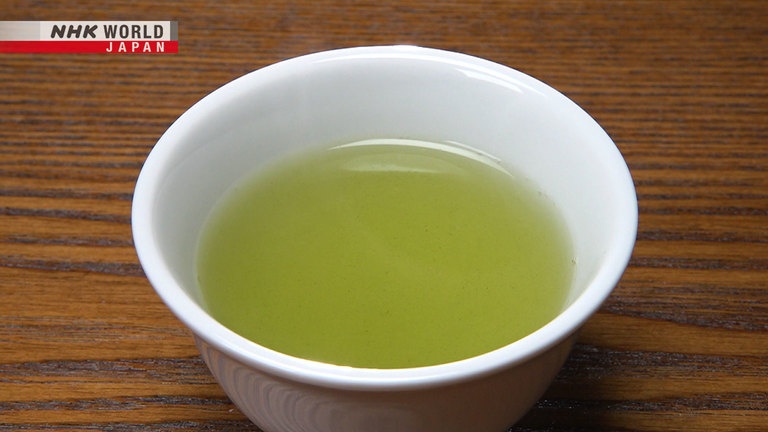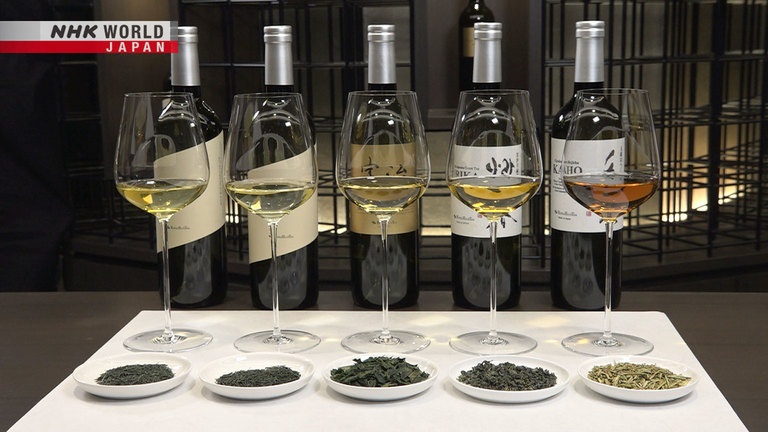JAPANESE TEA
Dip into the vibrant world of Japanese tea to sample different aromas and flavors at a specialty shop. At a tea farm using a novel method, a shop owned by a former researcher selling 70 types of leaves, and a restaurant teaching the principles of food and tea pairing, discover how today's experts are keeping tea's evolution alive. (Reporter: Zack Bullish)




Transcript
Tokyo: this world-class metropolis is a veritable gourmet wonderland.
Discover the stories behind the ingredients that make this city so delicious - so "oishii."
Today, we focus on Japanese tea.
Its aroma and flavor hit the spot when it's time to unwind.
Japanese tea, Chinese tea, and black tea leaves all come from one plant species called Camellia sinensis.
The difference lies in how they're processed.
After arriving over 1,000 years ago, tea continued to evolve in unique ways in Japan.
Invigorating.
Lovely aroma.
Now, Japanese tea is entering a whole new era.
- This is Japanese tea?
- It is.
Offering colors and aromas that defy imagination.
Pure bliss.
The endless possibilities of Japanese tea offer a little something for everyone.
Trails to Oishii Tokyo.
Hi, I'm Zack Bullish.
Even foreigners who've lived in Japan for a long time don't really know about tea drinking in Japan.
Of course, if you go to the convenience store, there's an array of bottled tea, and if you go out to eat sushi, it's all-you-can-drink green tea.
But this is only a small sliver of tea drinking in Japan.
Let's dive deep into the Japanese tea of today, a vibrant culture that the world has yet to know.
Come on, let me take you there.
Zack begins at a specialty tea shop in Tokyo.
It says to take off your shoes.
Is this someone's home?
Zack complies and heads up stairs.
Oh, there's a bar counter.
- Hello.
- Welcome.
- Here is the menu.
- Thank you.
- This is all tea?
- That's right.
- No coffee or anything?
- No coffee here.
- Purely a tea shop.
- Yes.
Tamai Daisuke has been fond of tea from a young age.
He opened this shop in 2018.
Tamai is also knowledgeable in tea ceremony tradition.
Today, he focuses on the basics.
First, he prepares "matcha," a powered green tea with a rich history.
Thank you.
Tamai wants his customers to enjoy tea without worrying about etiquette.
- "Oishii."
- Thank you.
- This is very strong.
- Right.
And the cup is very pretty.
It covers your face when you hold it up.
Right, it does have an oval shape.
You can fully take in the aroma that way.
What you drink out of greatly affects the overall experience.
Tea plant seeds were likely brought from China in the 9th century.
"Matcha" production started later, in the 12th century.
A Japanese Zen master named Yosai is thought to have brought the culture home to Japan after visiting China.
At the time, tea was a luxury mainly enjoyed by aristocrats and samurai.
"Matcha" is green tea leaves that've been ground into a fine powder.
The process takes a lot of work.
During photosynthesis, umami compounds in tea leaves take on a bitter flavor.
To prevent this, farmers keep them out of direct sunlight for a period of time before harvest.
Once harvested, the leaves are steamed and dried to make what is called "tencha" tea.
It's then stone-ground to make "matcha."
Add hot water, stir it with a bamboo whisk, and serve.
Next is "sencha" tea.
Put the tea leaves into a "kyūsu" teapot and pour in hot water.
I've never seen this type of teapot.
Its shallowness helps the leaves
soak up water thoroughly.
I'm using it because it's fun to
watch the leaves expand.
"Sencha" grew popular starting around the 18th century and is still the most familiar type in Japan today.
You can taste the sweetness of the leaves,
and it's not bitter at all.
Very enjoyable.
Most Japanese tea leaves are steamed.
Doing so immediately after harvest prevents oxidation, keeping their color and flavor intact.
After that, the leaves are gently kneaded.
This stimulates flavor compounds as they dry.
What will he make next?
Is it just a bowl of "sencha" leaves?
It has a sweet fragrance.
- This is called "gyokuro" tea.
- "Gyokuro?"
Like "tencha," "gyokuro" is also the product of leaves that are shielded from the sun for a period of time.
The umami-rich product is very high-end, and only a small amount is produced.
Pour warm water, around 40 degrees celsius, over a large amount of tea leaves.
That's it?
A flatter teapot allows for less water to be used for brewing.
How luxurious.
With this strong of a flavor,
you could almost eat rice with it.
Surprising.
How do you read this one?
- "Ichocha."
- "Ichocha?"
It's oxidized tea leaves.
It's not widely produced,
but it's gaining popularity these days.
- Only recently?
- Yes.
Leaf oxidation is more common with Chinese and black teas.
"Ichocha" is the only Japanese tea made using a similar method.
Tamai has also grown fond of it.
It's a bit different from the others.
As if it contains spices.
The aroma fills your mouth.
A nice fragrance can improve the mood
and stimulate a conversation.
- So true. Very interesting.
- Indeed.
Extra aromatic - a new wave of Japanese tea.
Zack heard about a producer in Hidaka, Saitama, who was quick to jump on the "ichocha" bandwagon.
The area produces "sayamacha," a tea popular all around Japan.
The first tea crops of the year are ready between spring and early summer.
- Good morning.
- Morning.
What are you working on?
This is a tea garden for hand picking.
Leaves are hand-picked for tea.
- All hand-picked?
- That's right.
Shimizu Keiichiro heads a tea wholesaler that's been around for 150 years.
He says hand-picking, rather than using mainstream plucking machines, produces higher quality "ichocha."
Plants don't all grow at the same rate.
Some sprout sooner than others.
Hand picking allows us to choose
the ones that are just right.
In particular, the softest sprouts, called "three leaves and a bud," are used to make high-end "ichocha."
Zack joins in to help.
Pick three at a time.
Knowing they'll be sold
makes me want to be careful.
It's scary.
- You're doing great.
- Yeah?
But something keeps distracting him.
I'm not sure if saying "leafy smell"
would be enough to explain it.
- You should stay focused.
- Oh, right.
Sorry, I got sidetracked.
I'm on it.
Harvest-ready tea leaves need to be picked within two weeks.
For standard "sencha," leaves are immediately sent to a factory for steaming.
Shimizu prefers another way.
Leaves are spread out over a mat in the sun.
This begins a withering process called "icho," hence the name "ichocha."
It's long been known that tea leaves
become more fragrant as they wilt.
Oxidizing teas like black and oolong
takes advantage of that process.
Japanese tea is more about umami, so
not much emphasis is put on aroma.
The first step stimulates the oxidase enzymes in the leaves.
This releases a sweet, almost floral fragrance.
Japanese "ichocha" is still in its infancy.
Shimizu frequently visits Taiwan and Sri Lanka to study methods used for Chinese and black tea production.
The leaves have now been sitting out for 20 minutes.
- It's developed a fruity aroma.
- Right?
This step keeps the leaves dry and makes sure they all receive an equal amount of sunlight.
Wow. Even stronger now.
- Strong aroma, right?
- Stronger than before. Very exciting.
Exactly.
Doing this really brings a smile to my face.
One hour has passed.
They're very soft now.
Is this how they need to be?
The "icho" process needs to be thorough.
Otherwise, they'll get damaged.
After the outdoor process, indoor oxidation begins.
The oxidase enzymes are activated further by tossing the leaves.
This makes them even more aromatic.
Patience is key.
They're tossed in intervals of one-and-a-half to four hours.
The sun has already gone down by now.
Look how withered they've become.
Chinese oolong tea production is fairly similar.
But for black tea, the process continues until the leaves turn a darker color.
Now they're ready for pan-frying.
The heat will deactivate the oxidase enzymes.
The leaves are lightly kneaded while still hot, and placed into a dryer.
Work continues into the following day.
During the first harvest of the year, they're too busy to sleep.
After taking them out, he'll remove the hard stems, and the aromatic "ichocha" is complete.
- Very delicious.
- Thank you.
What made you want to start making "ichocha?"
Tea has often been offered for free.
Standard Japanese tea, that is.
Right. You can get free tea in many places.
There should be more Japanese
tea that people are willing to pay for.
I think something like "ichocha" can
play a big role in that sense.
"Sayamacha" has a reputation for great flavor, so enhancing aroma can only boost its popularity.
Shimizu's father had the same idea, and started using the "icho" method, which was very unconventional at the time.
Shimizu carries on his legacy, aiming to one day make the region famous for quality "ichocha."
In Tokorozawa, another "sayamacha" production area, there's a specialty shop selling varieties of tea leaves.
Racks of plants are seen out front.
"Benifuki."
"Sofu."
"Musashi-kaori."
Are these varieties of tea?
Some people like picking their
own leaves to make tea with.
You can make tea using leaves
you pick here yourself?
How fun!
Kawaguchi Fumiki worked as a researcher involved in the development of tea varieties.
Most Japanese tea is sold as a blend, so he opened this shop in 2016 to show people what they were missing - the unique traits of each variety.
We sell tea leaves packaged by variety.
Over 120 varieties of Japanese tea exist as of 2022, and he has around 70 here.
Unique.
- These are all unique varieties?
- Yes, these are the specialized teas.
Corn and edamame aroma?
- That kind of tea exists?
- Yes.
Texas burger? You mean you
should drink this with your burger?
Well, it's tea with a slight
burger or grilled flavor.
I'll pass!
He writes flavor descriptions next to each item.
There's even a graph showing the flavor and aroma characteristics of each type.
Zack will try a few.
Let's start with "yabukita," a standard type.
"Yabukita" is a superstar, accounting for 70% of Japanese tea cultivation.
It was created in Shizuoka at the beginning of the 20th century.
- Well-balanced. Full-bodied with nice umami.
- Right.
I think I see something floating.
Am I seeing things?
They're trichomes, hairs on
the surface of young tea leaves.
- Hair?
- Yes. It proves the leaves are of high quality.
Next is "Kurasawa."
If you like bitter tea, this is the one for you.
It makes your face do this.
Bitter tea resets the palate after
eating sweets, especially Japanese sweets.
It makes you want to eat something sweet, yeah.
Now for "yamakai," a.k.a the texas burger tea.
- Now I know what you mean.
- That's a relief.
It's like a BBQ flavor.
"Yamakai" has a cooked soy sauce or
BBQ sauce flavor, with a hint of mayonnaise.
Like "okonomiyaki" sauce and mayo, yeah.
Kawaguchi was involved in developing this next one, called Sun Rouge.
It's a crossbreed of varieties that have reddish leaves.
It's like a warm hug.
Kawaguchi recommends adding drops of lime juice.
Wow. It turned a lovely pink color!
Beautiful.
The color changes because
it's high in anthocyanins.
They're water-soluble pigments that
alleviate strain on the eyes.
So, this was developed with an
emphasis on health benefits.
Wait, is this considered Japanese tea?
Yes.
A type of green tea, actually.
- Green tea?
- Yes.
The sky's the limit with this stuff.
Back in Tokyo, Zack heads to a shop in Roppongi that's been offering tea in a novel way since 2017.
Is this a wine shop?
Seems so, right?
But it says tea.
It's tea? Sold in bottles?
All the bottles have tea in them.
The shop uses their own technology to slowly produce cold brew tea over the course of three to seven days.
So, how does it taste?
Let's head to the bar to find out.
Chilled tea is served in wine glasses.
Just like with wine, enjoy the color
and aroma before taking a sip.
Thank you.
Nice color.
This is "gyokuro" from Yame, in Fukuoka.
Delicious.
Strong umami, very high quality.
- Soil provides the base umami.
- Soil?
Right. The production area's climate
influences the nature of the soil.
They select tea leaves from famous production sites across Japan.
Just like wine, the flavor reflects the characteristics of the tea's region.
This is a "sencha" variety from Tenryu, Shizuoka.
It's only harvested once a year.
Leaves are picked in one day by several hundred people.
- "Oishii."
- I'm glad.
This is "tencha" from Uji, Kyoto.
If you remember, it's what "matcha" is made from.
It's rarely sold in stores in this form.
- Each one has slightly different umami.
- Right.
In Uji, people grew tea on land fertilized
with food waste from aristocrats.
That increased salinity in the soil,
which I think affects umami.
Very interesting.
Why sell tea in bottles?
I don't drink alcohol.
Many people like pairing
alcohol with fancy dishes.
I wanted to offer a similar experience
to people who don't drink alcohol.
Zack will now pair the teas with some Japanese cuisine.
This is one of their lunch sets.
This is so good.
I'd like to try "sencha" with this.
I was right.
The egg has a Japanese flavor,
so I thought steamed tea would go best.
Well done. Impressive.
Really? Thanks.
With pumpkin cooked in sweet broth, he tries "tencha."
I went with a bitter tea to cleanse the palate.
Great balance. Delicious.
To go with eel sushi, Zack's favorite, roasted "gyokuro" tea.
The stalks were roasted slowly at a low temperature.
Pure bliss!
It's the same satisfaction you get when
pairing nice alcohol with nice food.
That's exactly what we're going for.
Quality tea is just as satisfying
with food as quality alcohol.
I hope this way of enjoying tea grows more popular.
Japanese tea has been growing in popularity in the West due to its amazing health benefits.
And now, with attention being brought to the uniquely nuanced aromas and flavors of different strains and harvest, Japanese tea is dawning a new era in Japan as well.
I particularly liked "ichocha."
It combines the delicious flavor of green tea with the aroma of black tea.
The delicious world of Japanese tea awaits your discovery.
Check it out!
In Tokyo, every ingredient has its own story.